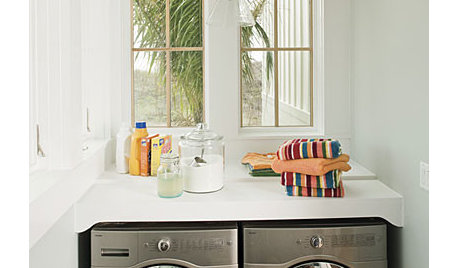Need cleaning tips for my Asko washer
housemama22
18 years ago
Featured Answer
Sort by:Oldest
Comments (19)
spewey
18 years agolast modified: 9 years agohousekeeping
18 years agolast modified: 9 years agoRelated Discussions
ASKO washer / dryer
Comments (3)I share your frustration with ASKO/Texas customer service personnel. I've owned my machines since the early 90's and they have always been that way. Really quite maddening! I don't think there is a printed service manual. I do have an electronic one (CD, I think, not download) I bought from them some years ago. Mine are earlier machines than yours, though, so I doubt my copy of the manual would help you. I think my DH talked them into selling it to us, which as I recall they were reluctant to do. I don't think it was a particularly useful in how to do repairs, though it did come with an expanded parts diagram which has helped reduce the number of wrong parts we have ordered from on-line retailers. One other note, my serial number indicates the machines were produced in 1993, but experience has taught me to order parts from 1992 models since apparently mine was made in early January of 1993 of parts left over from before the Holidays. Doesn't matter in all cases, but is critical for some. My DH (who is not a professional repairman - though IIRC, he might have, sort of, left the vague impression that he was one when he was winkling out the electronic parts manual from ASKO) does all our repairs. He is handy with electronic things, but feels the ASKOs are pretty straightforward -at least those of our vintage - and so not too hard to figure out repair-wise on the few occasions we have needed some work. The only other tip I have to offer is to call very early in the AM, when you can remain camped on until they pick up the phones. Otherwise you're in busy-signal or recorded message hell for hours. HTH, Molly~...See MoreLG Washer Owners useful cleaning tips
Comments (17)An additional point to mention: Thanks to everyone's advice on this forum, we learned many great tips that manuals either don't mention or they gloss over. Several posters have mentioned to empty the remaining water from the detergent dispenser in order to reduce the chance of mildew. Along with wiping down the gasket, leaving the door open, etc., we dutifully emptied the detergent dispenser (usually about a teaspoon or so of water left in there.) Only recently did we accidentally find that we can remove not only the dispenser that holds detergent, but the entire drawer that includes the detergent, bleach, and softener dispensers. And when we empty the entire drawer, we easily get a quarter cup of water. That's way more water than what's left around the gasket or on the inside of the door. This may have been mentioned in previous posts and we just missed it, but maybe mentioning it again might help a few more folks. Of course, we may just be the last folks in the universe to find this out! :)...See MoreAsko washer - dingy clothes
Comments (10)I have to agree w/ couple posters above. 1-2 tbls of laundry detergent is not enough for larger or large loads. From what I read here, people try to use as little as possible but it does more harm than good. Specially if you have hard water. Hot water is a must and so is extra rinse or two. For example: full load of heavy towels will need more detergent and lots of extra water to rinse it too. When I do towels only load, I never use more than 1/2 size load and always add 2 extra rinses to it and water plus. Usually it is better to do mixed loads,heavy/light all together. It rinses out better. I only have white/light loads or dark. Bigger washer isn't necessary better IMO. You can stuff ton in it, it will wash it good w/ proper amount of detergent but it won't rinse out good. It will take several extra rinses to make sure there is no residue left. My tiny FL does better job than the big one. I think they build these water conserving machine on purpose. They know people will feel bad using extra water and so over time it will ruin the laundry and the machine which it leads to buying new machine and more clothes. Personally I don't care If I use lots of water. Our laundry is clean and whites are white. I have towels from 15 years ago that are still white and the edges just starting to frey. Towels for 2.50 from biglots! I don't use bleach ever. So don't be affraid to use more detergent and extra rinse....See MoreNeed tip on cleaning my iron
Comments (11)Betty, In the days before Iron Cleaner came out, I used a sheet of waxed paper spread with salt and ran the hot steam iron over it. Alternating with ironing a couple layers of paper towels until the iron was clean. Then wipe bottom of iron with warm wet cloth to remove all residue. Hope this works for you. Jacke...See Moresshrivastava
18 years agolast modified: 9 years agoaquarius2101
18 years agolast modified: 9 years agohousemama22
18 years agolast modified: 9 years agohousekeeping
18 years agolast modified: 9 years agosshrivastava
18 years agolast modified: 9 years agowhirlpool_trainee
18 years agolast modified: 9 years agospewey
18 years agolast modified: 9 years agosshrivastava
18 years agolast modified: 9 years agosshrivastava
18 years agolast modified: 9 years agosshrivastava
18 years agolast modified: 9 years agohousemama22
18 years agolast modified: 9 years agosshrivastava
18 years agolast modified: 9 years agosuziesuesue
17 years agolast modified: 9 years agosshrivastava
17 years agolast modified: 9 years agohousekeeping
17 years agolast modified: 9 years agokkanuck
16 years agolast modified: 9 years ago
Related Stories

MOST POPULAR33 Magic Household Cleaning Tips
Houzzers from around the world share their tips for transforming housework into child’s play
Full Story
CLEANINGEco-Friendly Tips and Tricks for Cleaning Your Home
Are you wary of using chemicals to clean? These simple products and tricks will keep your home spotless naturally
Full Story
REMODELING GUIDESContractor Tips: Advice for Laundry Room Design
Thinking ahead when installing or moving a washer and dryer can prevent frustration and damage down the road
Full Story
LAUNDRY ROOMSLaundry Makes a Clean Break With Its Own Room
Laundry rooms are often a luxury nowadays, but a washer-dryer nook in a kitchen, office or hallway will help you sort things out
Full Story
KITCHEN DESIGNA Cook’s 6 Tips for Buying Kitchen Appliances
An avid home chef answers tricky questions about choosing the right oven, stovetop, vent hood and more
Full Story
KITCHEN DESIGNHow to Keep your Dishwasher in Tip-Top Shape
As your dishwasher goes into overdrive, here are a few tricks for getting your plates, glasses and silverware sparkling clean
Full Story
MORE ROOMS6 Garage Organizing Tips That Really Work
National Clean Out the Garage Day: Here's how to clear the clutter and organize what's left
Full Story
FEEL-GOOD HOME8 Tips for Harmony in the Kitchen
Frustrated by the arguments that arise over kitchen duties? Check out these coping strategies
Full Story
HOUSEKEEPINGTackle Big Messes Better With a Sparkling-Clean Dishwasher
You might think it’s self-cleaning, but your dishwasher needs regular upkeep to keep it working hard for you
Full Story
HOUSEKEEPINGThe Best Way to Get Your Windows Spotlessly Clean
Learn the pros’ tips and tricks for cleaning windows and getting them streak-free
Full Story


nycubsfan